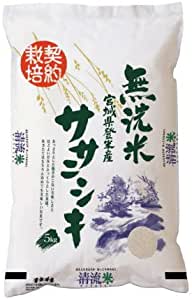Comparing Japanese Branded Rice Varieties – Yukiwakamaru, Akita Komachi, Haenuki, Sasanishiki, Mizukagami

In this article, we will be comparing and reviewing five different branded rice varieties from Japan that we have tasted: Yukiwakamaru, Akita Komachi, Haenuki, Sasanishiki, and Mizukagami.
Each variety will be evaluated on the following criteria:
- Taste and flavor, appearance
- Cooking method and water usage
- Recommended consumption
We will start by presenting our own personal “image” of each rice variety at the beginning of each section. Without further ado, let’s get started!!! (By the way, all of the rice varieties reviewed are non-wash types!)
We hope you will also enjoy reading this article as a form of entertainment.
- Yamagata Prefecture’s Yukiwakamaru Special Grade A Rice
- Selected Akita Komachi Rice from Akita Prefecture
- Yamagata Prefecture’s Haenuki white rice ranked special grade A in taste
- Miyagi Prefecture’s Tome-grown Sasanishiki rice
- “Mizukagami” Special Grade, recommended by Shiga Prefecture
- Summary: Enjoying the Unique Flavors of Each Rice Variety
Yamagata Prefecture’s Yukiwakamaru Special Grade A Rice

The first brand of rice that appeared in the purchase history from about six months ago!

it can be referred to as the “White Nobleman of Snow Country”!
According to the product introduction comment,
this rice has superior taste, whiteness, appearance, luster, and flavor compared to “Haenuki” rice. It also has a new texture that combines a firm grain feel with moderate stickiness, creating a balance of stickiness and hardness that has not been seen before when compared to other varieties of rice. This trend is consistent even when compared to other branded rice varieties from different prefectures.
This information was found on Amazon’s “Product Description.”
I see. It sounds like the brand has a well-made website(Japanese) as well. As for the taste of the rice, while some aspects are similar to the product description, the site’s administrator would like to give a slightly critical evaluation.
Taste and flavor, appearance
The first point that the administrator would like to address is the whiteness of the rice after cooking. The rice has a matte whiteness rather than a transparent one, which gives it a powerful appearance befitting its name.
When tasted, the rice has a firm texture that could be described as “sticky” in a positive sense. As stated on the brand’s website, the grains of rice are quite large, and even a small mouthful provides a satisfying feeling of eating a substantial amount of rice. However, despite its size and texture, the rice is not overly sweet or bland, but rather has a subtle taste.
Indeed, even as rice, the White Nobleman lives up to its elegant name!
Cooking method and water usage
There doesn’t seem to be a significant difference in taste or texture depending on the amount of water used for cooking. If you cook it with less water, the rice becomes a tight and compact nobleman, while using plenty of water results in a plump nobleman.
Rather than becoming harder or softer, the difference in the expression of the texture of the rice is due to the nature of the Yukiwakamaru itself.
However, since the grains are large, using more water causes them to expand and become closer to a “sticky” sensation.
The variety lineage of “Yukiwakamaru”

Looking at the lineage of “Yukiwakamaru” from the above database, it can be seen that it has ancestors such as “Akitakomachi,” “Hitomebore,” and “Haenuki,” which are also well-known members in the modern rice industry.(On the right end of the lineage chart is “Yukinowakamaru”.)
Although we have reviewed these varieties in this article, none of them are particularly large or strong in flavor. It seems that “Yukiwakamaru” has gained its power without being overly strong in flavor, thanks to the interesting nature of rice as a crop.
Recommended consumption
Those who want to fully experience the taste of rice
Some people may say that “Yukimaru” is not suitable for onigiri (rice balls) because of its large size, but I think it’s not true. Each grain stands out, so even when it’s cold, you can still savor the taste of the rice and even salted rice balls won’t leave you feeling unsatisfied. (I once found Yukimaru salted rice balls at Lawson convenience store!)
On the brand’s website, it is written that it also goes well with curry and fried rice. As the site suggests, I felt that because of its large size, it tends to absorb sauce or broth easily and can become a bit mushy. However, that doesn’t make it any less delicious!
Therefore, I recommend trying it first freshly cooked, one bite at a time, especially for those who want to fully taste the flavor of the rice.
Selected Akita Komachi Rice from Akita Prefecture

If we were to give it a character, it could be described as a…

Tsundere princess with hidden deliciousness.
Despite its name being used for its character design, when purchased on Amazon, it comes with a small bag of chili peppers as a natural insect repellent.
The product description states that,
“Akita Komachi” is a rice born in Akita, rich in luster, stickiness, and elasticity, nurtured by a rich land. It is a rice that is perfect for children’s bento boxes and onigiri, with a delicious taste that does not change even when cold. It is a must-try for those who are looking for delicious rice.
This introduction seems to apply to any kind of rice, doesn’t it? Let’s take a look at the reviewer’s impression!
Taste and flavor, appearance
The first impression when I switched from the rice I was eating before to Akita Komachi was that the taste was somewhat bland. The grains were not particularly prominent, nor were they stuck together and flattened, but they had come together as a whole.
However, as I continued to savor it, I noticed a faint sweetness like Kaguya-hime sleeping inside the bamboo deep within each grain of rice. (Although it might be unpleasant for Akita Komachi to be likened to Kaguya-hime…) Moreover, this sweetness was very distinct even though it didn’t assert itself. Perhaps it was the reason why it tasted unexpectedly delicious and I found myself eating more.
Cooking method and water usage
The subtle and distinct flavor is not influenced much by the cooking method. Whether the rice is cooked with less water to make it firm or with more water to make it soft, this sweetness remains present throughout.
If anything, the flavor can’t be fully appreciated if you swallow it without chewing much, so I personally prefer to use a little less water and chew the rice well to fully savor its subtle taste.
“Akitakomachi” variety lineage

“Akitakomachi” is a variety that began development in 1975 and has a long history. Looking at its ancestors, there are names of varieties that are not commonly seen today. (Akitakomachi is on the far right.)
I was surprised to learn that “Koshihikari” is its direct parent. Despite that, I think it has a refreshing and straightforward taste.

I also checked the taste comparison based on “Koshihikari” as a standard, although the data is quite old (1985). The overall evaluation is 0.02, which indicates a very close result. It’s understandable that the taste umami is -0.07 compared to Koshihikari.
Recommended consumption
Those who want to enjoy it with various dishes.
I think this is the most versatile rice among those we have introduced this time.
Although it may be described as having few distinctive features, it can actually enhance the taste of any dish by complementing it. It’s great with mixed grain rice, onigiri, and okayu (rice porridge). It works well with almost any rice-based dish.
The grains are not too big, making it easy to eat and enjoy.
Yamagata Prefecture’s Haenuki white rice ranked special grade A in taste

I picked up this variety of rice in search of a refreshing taste. Its name comes from a purebred Yamagata local, but to put it in words,

it’s a rugged and sturdy young boy grown in the mountainous region.
Regarding the product:
Haenuki is a representative rice of Yamagata, a famous rice-growing region in Japan. It has a strong stickiness and sweetness, and its characteristic is that it is difficult to lose its shape even when it cools down.
The evaluation of “22 consecutive years special grade A” in the taste test by the Japan Grain Inspection Association is only given to two types of rice, “Uonuma-grown Koshihikari” and “Yamagata Prefecture-grown Haenuki”.
It is used in onigiri (rice balls) sold in major convenience stores.
So, it has been receiving the evaluation of special grade A for a long time. However, personally, I have some doubts about it.
Taste and flavor, appearance
I got the impression that it was a very light and refreshing type of rice. Beyond being light, I remember not feeling much taste at first. I wonder if the rice itself has a lower moisture content or if it tends to become dry after cooking. That’s why I’m a little skeptical about the special grade A rating mentioned above.
However, as you get used to it, you start to understand that this is the taste of Haenuki rice. If you pay close attention, you can detect a chestnut-like flavor and aroma hiding in the background. The sweetness is quite subtle, but that’s what makes Haenuki rice unique. Each individual grain seemed to speak for itself, saying “this is what Haenuki rice is all about”.
Even the uncooked rice has a rough, almost grayish color, giving me a sense of the determined spirit of Haenuki rice, which is forging its own path.
Cooking method and water usage
The introduction mentions that the rice maintains its shape even when cooled down, but if there is too much water added, the texture can become mushy. If cooked too hard, the rice can become dry and crumbly, making it a truly stubborn type of rice.
Since the range of water and cooking time for achieving one’s desired texture and taste is narrow, it’s important to be cautious when trying to cook this rice. However, this stubbornness is well worth it, as the rice has a flavor that can stand up to it.
“Haenuki” variety lineage

As “Akita Komachi” is a parent variety, “Koshihikari” is also included in its ancestry. (The variety on the right end is “Haenuki”.) Perhaps, because it also inherits the blood of “Sasanishiki”, it has achieved a unique position as previously mentioned.

There is some old data that compared the taste of “Sasanishiki” and “Haenuki” rice. Although the overall evaluation can be left aside, personally, I noticed the item “stickiness” in the comparison. As mentioned in the review, “Sasanishiki” is characterized by its refreshing taste, so it could be said that “Haenuki” is positioned as having added stickiness to that.
Recommended consumption
Those who are looking for a unique flavor.
Since “Haenuki” often has a light texture when cooked, it is recommended to enjoy it with dishes that have some liquid. Curry and rice bowls are great choices.
Natto rice, for example, pairs well with this rugged type of rice and creates a delicious combination (although some people may not be fond of natto). Its sweetness tends to come out more when it cools down, so shaping it into rice balls or packing it in bento boxes is also a great option.
Miyagi Prefecture’s Tome-grown Sasanishiki rice

The journey of seeking flavor within the light and refreshing taste has come to an end with “Sasanishiki” from Tome, Miyagi Prefecture. The website of the retailer can be found here.
This rice is, so to speak,

The prince of “mono no aware” (elegant sadness)!
Sasanishiki, which used to be as popular as the east yokozuna Sasanishiki and the west yokozuna Koshihikari, is an rice variety that people sought out for its light yet flavorful taste. However, due to the difficulty of cultivation, there are few producers in recent years, and it has become known as a “phantom rice”.
The current mainstream rice varieties have a strong chewy and sticky texture, making them difficult to eat when saliva is hard to come by, such as in the morning.
Sasanishiki, on the other hand, has a less sticky texture and a pleasant throat feel as if it melts in your mouth, making it easy to eat.
This is exactly as it is described!
It’s interesting to note that Sasanishiki was once called the east yokozuna, indicating that it was highly regarded. Although Niigata and Miyagi are not exactly close, it’s still a sort of east-west comparison.
Taste and flavor, appearance
As the description mentions, this rice is incredibly light and refreshing. This doesn’t mean that it lacks flavor, but rather its lack of chewy texture allows you to smoothly and simply savor the taste of the rice.
The grains are perfectly cooked so that they stick together just enough to make each bite substantial, yet they also separate easily, allowing you to fully enjoy the flavor. While it doesn’t have a bold sweetness, a gentle sweetness lies within the rice, which slowly permeates your mouth as you chew.
The light and silky texture of the rice allows you to keep taking bite after bite, and the aroma of the rice when cooked gives you a sense of the refreshing breeze that flows through the rice fields, and the grassy scent reveals the true essence of the rice.
At times, it even has a fragrance similar to jasmine rice.
Cooking method and water usage
I see. So this rice can be enjoyed even with less water and it won’t become too hard.
Since it has a light and fluffy texture, it’s not recommended to use too much water when cooking. It doesn’t seem to be the type of rice that absorbs a lot of water and becomes firm and chewy.
This elegant prince prefers a light and airy texture that dances in the wind.
“Sasanishiki” variety lineage

According to the text, “Sasanishiki” is a very experienced variety of rice that was developed in 1953. Its ancestors’ names are rarely seen nowadays. The text also mentions that “Sasanishiki” has undergone several crosses, such as BL1, BL2, BL3, to enhance some of its traits, including resistance to rice blast disease.
A disease in which the fungus infects rice plants during germination, penetrates the epidermal cells of the rice plant, and causes the leaves and ears to wither. It has been feared for a long time because it has a significant impact on crop yields.
Recommended consumption
Those who want to fully enjoy the original aroma of rice.
This rice is also a versatile type. Despite having a strong flavor of its own, it does not overpower other ingredients, so it can be paired with any dish. It can absorb broth well in dishes like beef bowl, and also goes well with dishes like doria or paella.
However, the best way to enjoy it is to savor the abundant aroma by slowly and carefully enjoying slightly firm freshly cooked rice.
“Mizukagami” Special Grade, recommended by Shiga Prefecture

The author of this article had Mizukagami for lunch today, and it was delicious!
When it comes to the management’s image of Mizukagami,

It might be described as cute yet with a craftsman’s temperament!
a new type of rice developed by Shiga Prefecture. It has become popular as a delicious rice with a taste equivalent to or better than “Koshihikari.”
It is cultivated with consideration for Shiga’s natural environment, including Lake Biwa. The rice has a characteristic white color and a glossy appearance when cooked. It has a moderate stickiness and a smooth, sweet flavor when chewed, making it very delicious.
Furthermore, it remains tasty even when cold, allowing you to fully enjoy the original taste of rice in rice balls or lunch boxes. This rice is safe and reliable, and it is recommended that growing children eat it more often.
This is based on the description provided by Amazon, but the writer will provide their own personal evaluation as well.
Taste and flavor, appearance
I felt that saying “equal to Koshihikari” was a bit of an overstatement. Of course, the taste of rice varies depending on the production area and the quality of the harvest, but it still seems to fall short of Koshihikari.
The sweetness is solid, but sometimes it can feel a bit “vague.” Even when chewing, it’s easy to swallow without fully capturing the sweetness in your mouth.
The fragrance is not particularly strong, just the typical scent you would expect from rice cooked normally. The description also says it’s delicious even when cold, but it tends to become slightly firm when chilled. This could be a matter of personal preference.
The grains are small and smooth, and very beautiful before cooking. It’s also unusual for rice to have such a round shape, which I find cute, and it creates a contrast with its taste, leading me to describe it as having “craftsman-like quality” (laughs).
Cooking method and water usage
I understand that reducing the amount of water used when cooking the rice will result in a firmer texture with a good bite. For those who prefer firmer rice, this variety may be just right.
However, personally, I feel that this variety may not be suitable for the technique of reducing the amount of water used in order to bring out the plumpness of the rice.
Also, when adding mixed grains, it can easily become too dry, resulting in a very chewy and sticky texture.If using mixed grains, it is important to pay sufficient attention to the amount of water used.
“Mizukagami” variety lineage

Ah, I see. It’s a rice variety with a respectable lineage that includes “Koshihikari” and “Hitomebore.” Though, I feel that its taste is somewhat different from those varieties, but perhaps that’s due to differences in where it’s grown.
It’s fascinating how the expression of various characteristics can change depending not only on the crossbreeding of varieties but also on where they’re grown.
Recommended consumption
Those who want to enjoy it with generous servings of curry and other dishes.
As mentioned above, when it cools down, it becomes quite hard, so if you want to make rice balls, you should make them plump. Although the sweetness and fragrance are well brought out when freshly cooked, it is not so pronounced that you can immediately taste it in your mouth, so you may want some side dishes with it.
On the other hand, it may serve as a good complement to dishes. Therefore, it is recommended to eat it with dishes where the flavor is added to the rice, such as curry and mixed rice.
Summary: Enjoying the Unique Flavors of Each Rice Variety
It’s convenient to use online shopping when you want to try many types of rice from different regions. In this article, we introduced rice that was all purchased from Amazon, but in the future, you may want to try buying directly from the farmers.
In any case, there are many different types of rice with various appearances and personalities. So, enjoy tasting them all and find your favorites or the ones that may seem a bit unusual to you!
Here are the rice varieties introduced this time:
I think this can be a great opportunity for those who are viewing from overseas to feel the depth of Japanese rice. Please try various brands and enjoy the different tastes!
“Yukiwakamaru” – The White Prince of Snow Country
The first thing that catches your eye is the bright white surface of the cooked rice.
The tsundere princess with hidden deliciousness, “Akita Komachi”
The delicate sweetness that gracefully untangles is just like its name suggests.
Rugged young boy grown in mountainous areas 【Haenuki】
The unique taste is what makes it all the more enjoyable.
The graceful prince of refined elegance, Sasanishiki
The aroma of the rice being cooked is unparalleled! It will make you hungry.
Cute yet artisanal, Mizukagami
A variety where the beauty of the rice grains stands out.





